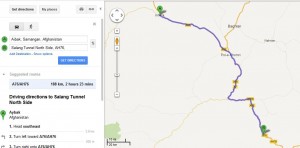More Evidence US Views Drone Strikes as Political Retaliation Tool
On the same day that the US and Pakistan formally signed the agreement reopening the NATO supply routes through Pakistan, a piece profiling the US-Pakistan relationship in the New York Times provides further evidence supporting the idea that the US sometimes uses drone strikes as a tool for political retaliation. The retaliatory strikes previously have been stepped up to almost one per day when a particular point is being emphasized.
The entire Declan Walsh and Eric Schmitt piece in today’s Times is worth reading, but I want to focus on the evidence they provide for drone strikes as retaliation. The piece focuses on the Haqqani network and how the perceived ties between them and Pakistan’s ISI complicate the US-Pakistan relationship. At one point in the article, the discussion moves to contingencies the US has considered about what the US would do if the Haqqani network manages to inflict a significant blow against US forces in Afghanistan:
But a new boldness from the Haqqanis that aims at mass American casualties, combined with simmering political tension, has reduced the room for ambiguity between the two countries. Inside the administration, it is a commonly held view that the United States is “one major attack” away from unilateral action against Pakistan — diplomatically or perhaps even militarily, one senior official said.
/snip/
American officials recently considered what that could mean. Days after the Salerno attack, the White House held a series of interagency meetings to weigh its options in the event of a major success by the Haqqanis against American troops.
/snip/
The meetings yielded a list of about 30 possible responses, according to a senior official who was briefed on the deliberations — everything from withdrawing the Islamabad ambassador, to a flurry of intensified drone attacks on Haqqani targets in Pakistan’s tribal belt, to American or Afghan commando raids on Haqqani hide-outs in the same area.
Gosh, “a flurry of intensified drone attacks” sounds very familiar. That is exactly what happened last May when Zardari’s visit to the NATO summit in Chicago did not produce the agreement for reopening the supply routes. Retaliatory strikes started almost immediately, with at least four strikes coming within a span of six days.
With the understanding that the US views drone strikes as a retaliation tool, we can watch this week’s visit to Washington by new ISI chief Lieutenant General Zaheer ul-Islam. Islam will visit with David Petraeus and others Wednesday through Friday of this week. Drones are expected to be on the agenda for the meetings:
Lieutenant General Zaheer ul-Islam, who was appointed in March, “will visit USA from 1st to 3rd August. This will be a service-to-service bilateral visit,” the statement said.
“He will meet his counterpart General David Petraeus, director CIA.”
The short statement gave no other details, but a senior Pakistani security official earlier told AFP that the pair would discuss counter-terror cooperation and intelligence sharing.
Islam would also demand an end to US drone attacks against the Taliban and al Qaeda, and again ask for the means for Pakistan to carry out the attacks instead, the security official said.
The US has made it clear multiple times that it will not give up on carrying out drone strikes and that it does not trust ISI enough to bring them closely into the loop when choosing targets or timing for strikes. It seems very likely to me that the US will carry out a strike within the first day or two after the meeting ends, just to send the message to the ISI that the meeting has changed nothing in how the US will operate. If the strike is as reckless as the one that killed a group of 40 who turned out to be mostly civilians on the day after the release of Raymond Davis, then the US could be accused of letting the need for political retaliation move it all the way to blind rage. Another hint in the Times piece tells us that Haqqani leader “Sirajuddin Haqqani surrounds himself with civilians — often women and children — at his base in the town of Miram Shah”. Will the US decide to allow some “collateral damage” to women and children in an attempt to take out Sirajuddin Haqqani as Islam returns to Pakistan from his meeting with Petraeus?


